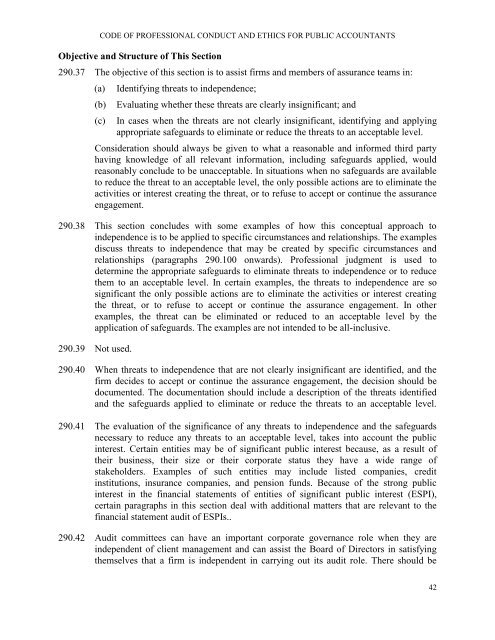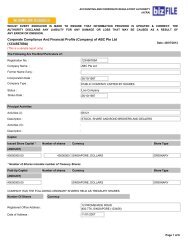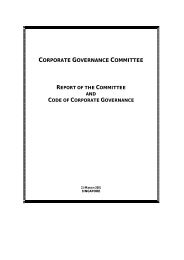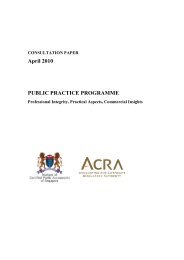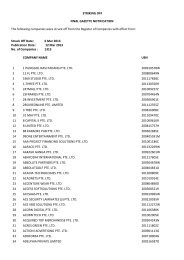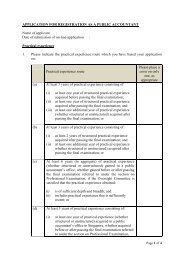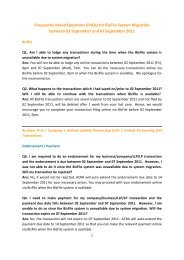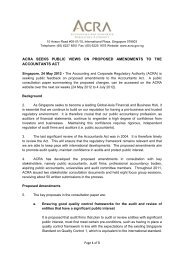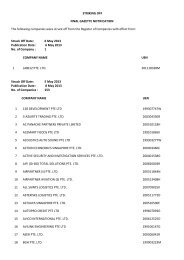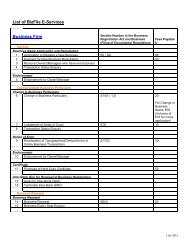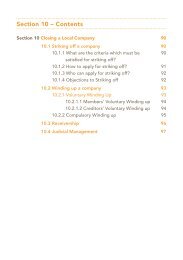Exposure Draft - ACRA
Exposure Draft - ACRA
Exposure Draft - ACRA
You also want an ePaper? Increase the reach of your titles
YUMPU automatically turns print PDFs into web optimized ePapers that Google loves.
CODE OF PROFESSIONAL CONDUCT AND ETHICS FOR PUBLIC ACCOUNTANTS<br />
Objective and Structure of This Section<br />
290.37 The objective of this section is to assist firms and members of assurance teams in:<br />
(a)<br />
(b)<br />
(c)<br />
Identifying threats to independence;<br />
Evaluating whether these threats are clearly insignificant; and<br />
In cases when the threats are not clearly insignificant, identifying and applying<br />
appropriate safeguards to eliminate or reduce the threats to an acceptable level.<br />
Consideration should always be given to what a reasonable and informed third party<br />
having knowledge of all relevant information, including safeguards applied, would<br />
reasonably conclude to be unacceptable. In situations when no safeguards are available<br />
to reduce the threat to an acceptable level, the only possible actions are to eliminate the<br />
activities or interest creating the threat, or to refuse to accept or continue the assurance<br />
engagement.<br />
290.38 This section concludes with some examples of how this conceptual approach to<br />
independence is to be applied to specific circumstances and relationships. The examples<br />
discuss threats to independence that may be created by specific circumstances and<br />
relationships (paragraphs 290.100 onwards). Professional judgment is used to<br />
determine the appropriate safeguards to eliminate threats to independence or to reduce<br />
them to an acceptable level. In certain examples, the threats to independence are so<br />
significant the only possible actions are to eliminate the activities or interest creating<br />
the threat, or to refuse to accept or continue the assurance engagement. In other<br />
examples, the threat can be eliminated or reduced to an acceptable level by the<br />
application of safeguards. The examples are not intended to be all-inclusive.<br />
290.39 Not used.<br />
290.40 When threats to independence that are not clearly insignificant are identified, and the<br />
firm decides to accept or continue the assurance engagement, the decision should be<br />
documented. The documentation should include a description of the threats identified<br />
and the safeguards applied to eliminate or reduce the threats to an acceptable level.<br />
290.41 The evaluation of the significance of any threats to independence and the safeguards<br />
necessary to reduce any threats to an acceptable level, takes into account the public<br />
interest. Certain entities may be of significant public interest because, as a result of<br />
their business, their size or their corporate status they have a wide range of<br />
stakeholders. Examples of such entities may include listed companies, credit<br />
institutions, insurance companies, and pension funds. Because of the strong public<br />
interest in the financial statements of entities of significant public interest (ESPI),<br />
certain paragraphs in this section deal with additional matters that are relevant to the<br />
financial statement audit of ESPIs..<br />
290.42 Audit committees can have an important corporate governance role when they are<br />
independent of client management and can assist the Board of Directors in satisfying<br />
themselves that a firm is independent in carrying out its audit role. There should be<br />
42


